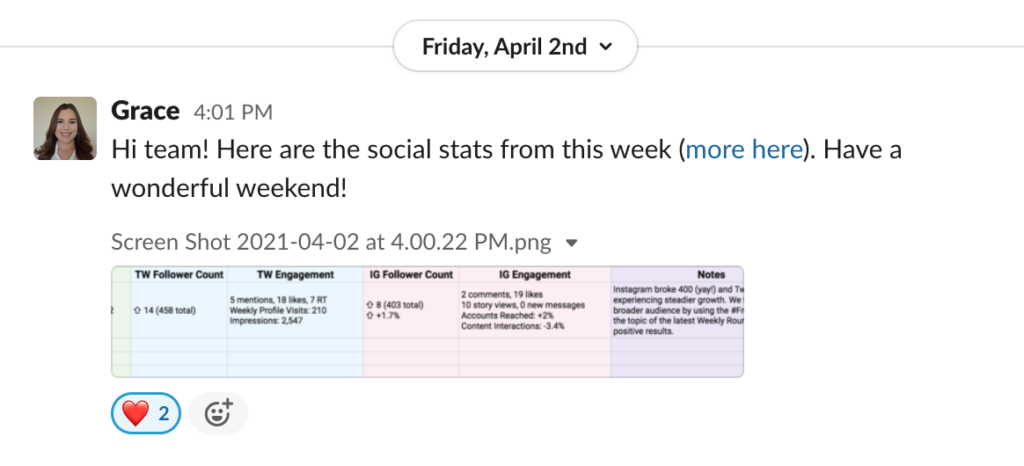If the thought of having difficult or uncomfortable conversations remotely makes you nervous, rest assured that you’re not alone. It can be daunting to approach certain types of remote communication over the phone or through the computer, especially without a bit of guidance beforehand.
Not to mention, it’s a bit obvious that communication in the remote landscape looks a lot different than sticking your head around your neighbor’s cubicle in-office. Nonetheless, it’s just as important to actively communicate with your team while working remotely — if not even more important.
Communication is at the heart of every successful remote business. It moves organizational goals through the pipeline, creates company culture, and keeps teams connected despite physical distance. But with communication comes the need to have difficult conversations — like hiring, firing, or providing feedback — all through a video camera or computer screen.
That’s what the Remote Work Tribe is here for. With more than a decade of combined remote work experience, the contents of this post will detail the remote communication software you need in your tool box, how to prepare for uncomfortable calls, and what to say during difficult conversations (plus what to not say).

For a play-by-play of how to handle any remote communication that comes your way, consider this robust guide of remote team communication strategies to be your virtual mentor.
- How do you communicate with a team remotely?
- How do you motivate a team remotely?
- What’s the difference between remote leadership and remote management?
How Do You Communicate with a Team Remotely?
For years, the concept of remote work was considered too ludicrous to be productive. Much of corporate America (and beyond) turned up their nose at the idea of a dispersed team.
How would the team get anything done if a manager wasn’t lingering down the hall to micromanage? How could the team brainstorm together if not in the same room? Then 2020 came along, and the novel coronavirus flipped that notion on its head.
Seemingly overnight, the majority of the world closed their doors on office spaces, coworking spaces, and anywhere that couldn’t give employees 6 feet of space between them. For the thousands of long-time remote workers, this shift was a welcome change — the playing field was suddenly even. But for office-workers-turned-remote-workers, that shift may not have been as seamless.

Chances are, that’s what landed you here in the first place: Trying to adapt to the digital landscape while still maintaining momentum, culture, and communication. So, that brings us to the question of the hour—if team members are scattered across the state, country, or globe, how do you communicate effectively?
The short answer is: often, in-detail, and kindly. It’s nearly impossible to over-communicate when working remotely. For the long answer, we have tons of content outlining just about every remote communication scenario you may find yourself in throughout your remote career.
As a preview, consider these high-level points for communicating with a team remotely.
1. Keep Communication Clear
Using clear communication seems simple in theory, but it’s no secret that simplicity can be awfully hard to achieve. In the quest to remain as personable as possible with employees, you should focus on the goals and context of the task at hand. Always lead with empathy to create room for conversation and allow employees to feel comfortable.
Before hitting send, be sure to self-edit. Always triple-check to address any typos and ensure any necessary files have been attached when necessary. When dealing with a complex subject, give your message some breathing room and revisit with fresh eyes in 20 to 30 minutes. This space will help give you a better perspective and reveal any mistakes you might have missed the first read through.

To keep communication as clear as possible, remember to consider the context.
2. Consider the Context
Whether you’re delivering the message or receiving it, considering the context for your co-worker could help prevent misunderstandings. A few examples of context are knowing your co-worker’s location, cultural norms, and native language. A level up would be considering whether your colleague is having a bad day, going through a rough patch, is burnt out, or just feeling off.
Be mindful of local timezones and holidays. While it may be 3 o’clock in the afternoon for you, it could be 6 in the evening for a coworker located on the opposite coast. In the same vein, “the day after Christmas” for you could be the start of Boxing Day for an employee in the U.K. Sending messages during these types of scenarios, especially about important information, can pressure employees into feeling like they must answer.
There are still boundaries in remote work for when an employee’s business hours end and personal hours begin. You must honor that.
Similarly, remain empathetic to what your remote employees may be dealing with. If a remote teammate has gone quiet due to an illness in the family or a bout of burnout, you must approach the situation with that context in mind. This doesn’t mean walking on eggshells or beating around the bush, but rather opening the conversation with empathy about how the employee may be feeling or a question about what they may need from you.
Lasty, be conscious of the platform used to deliver your message. From an email to a voice call, or a video call to a screencast, you want to remain cognizant of how your message is being received by the person on the other end of the screen. This leads us into our next tip, all about tone and body language in the remote environment.
3. Be Mindful of Tone and Body Language
Did you know that a massive 55 percent of communication is body language? Another 38 percent is the tone of voice, and just 7 percent is the actual words spoken. So, how can you adapt to an environment where non-verbal communication isn’t as prominent, like the remote landscape?
It’s not as hard as you may think.
Think about the dozens of Zoom or GoogleMeet video conferences you’ve attended recently. To improve your virtual body language while video conferencing with colleagues, your posture is everything. Sit up straight and look into the camera. Keep your arms uncrossed, as closed body language can you make you feel standoffish or cold.

“Posture not only shapes the way we feel, it also shapes the way we think about ourselves—from our self-descriptions to the certain and comfort with which we hold them,” said author and executive coach Carol Kinsey Goman. “And those self-concepts can either facilitate or hinder our ability to connect with others, to perform our jobs, and, more simply, to be present.”
Aside from posture, do your best to speak clearly and enunciate so teammates can easily understand you (regardless of their Internet connection). Likewise, remain cognizant of your tone. Tone does not translate equally between audio calls and written communication. More often than not, employees will assume the negative.
Case in point: Short replies from managers
Imagine an executive reviewing a recent report from a new employee. When the report is delivered, all the executive replies back with is, “Okay, thanks.” And on the other end of the screen, panic ensues.
In reality, the executive may have been distracted, in a meeting or in a rush. They could have been using voice-to-text. They could have not even read the report yet! More often than not, people don’t think about how their message will come across — but that doesn’t mean they have ill intentions. However, that won’t stop someone else from responding how they feel is appropriate.
As a manager, be conscientious of how your tone may come across in written communication Always default to assuming positive outcomes, especially when communicating over a tool like Slack.
When writing, enunciate your tone with formatting. Though being concise and direct can streamline operations, it can be taken as abrupt or rude without proper formatting — sometimes, including emojis, GIFs, or images can help convey the tone you intended.
For a general formatting rule of thumb, pivot between italics, bold, and capital letters, when and where appropriate.

- Italics — Use for light emphasis and to highlight quotes, names of publications, conversations or dialogues and stories. This feels strategic and creative.
- Bold — Use for strong emphasis. This feels informative and assertive.
- Capitals — Use to denote shouting or aggressiveness… and use sparingly, please. This FEELS chaotic, but in a good way.
As with all communication, make sure you’re constructing any paragraphs with clear, understandable sentences. Remember that commas, semi-colons, and periods are your friends, and should be used to break up chunks of text. In internal messages, like on a chat, don’t be afraid to throw in emojis like smiley faces, thumbs up, or balloons.
4. Designate Tools for Specific Remote Communication
Too many tools can equal too many places for people to comment and relay information. This can result in missed messages or people feeling bombarded by constant communication pings. When conversations are scattered across multiple channels — and across the globe — they can easily be lost in translation.
The key is to designate specific tools or platforms for specific communication types. If you’re curious about remote communication tools, you can go ahead and skip to the next chapter — we go in-depth about every remote work software you should have in your virtual tool kit. But if you’re curious about how to designate tools, consider these tips:
- Keep your questions and side conversation to chat apps, like Slack
- Send formal requests or action-related items via email
- Provide status updates through a project management tool
Create a system that works best for your individual team and be sure everyone is looped into these processes. Then, you can move on to motivating your team.
How Do You Motivate a Team through remote communication?
Now that you have a better idea of how to communicate remotely, let’s talk about how to motivate a team remotely.
In-person, it’s easy to give a teammate a high-five or shout them out in the company kitchen. You might feel like these scenarios can’t translate remotely, but they most certainly can. In fact, in order to keep a remote team motivated, you’re going to need to think outside the box to consider how you can directly recreate your methods of motivation virtually.
1. Convert In-Person Meets to Video Meets
More video calls will not equal a more motivated team. More for the sake of more is never a good thing.
However, when you work remotely, it’s easy to start to isolate yourself physically, mentally, and emotionally. This poses risks to both job satisfaction and well-being, and can even be a factor in occupational burnout.
By instating some time for routine video meets (think once per month), your teams can still get the face-to-face connection that a phone call can’t provide. This helps peers better connect, communicate, and collaborate — helping to boost overall team morale.
2. Build Camaraderie Through a Virtual “Water Cooler”
In-person offices are ripe with opportunities to strike up small talk, such as watercooler chats in the company kitchen. Remotely, you’ll have to create a virtual venue to discuss non-work-related things, like the latest in pop culture and TV or pets and families.
Since employees won’t have a physical office watercooler to gather around, designate a “water cooler” channel on your messaging platform. But don’t feel constricted to just the watercooler: Create channels for #TeamPets, or #CurrentlyWatching for employees to share their pups or latest TV binge.
Taking this step can bring teammates closer together and create a sense of company culture that can be lost without purposeful communication. Plus, it reminds each team member of the company and people they work for, and what each team member is working collectively towards.
3. Say Good Morning and Engage Often
This tip might seem simple, but it’s majorly important: Say good morning. One of the most dramatic transitions employees face when they work remotely is the lack of human interaction. And for some employees, they can even feel like their daily structure has gone awry.
Though it can be hard to avoid this issue entirely, you can help employees feel more connected even while physically apart. The best way to do this? Offer a simple “good morning” when the team hops online for the day.

Make time to chat over your morning coffee, it’ll help your remote team feel a little less remote. This encourages teammates to talk to their colleagues the same way they would if they were at the office. Also, this is a good time to assure employees that you’re available to help them along during their remote transition, particularly if certain team members aren’t as tech-savvy.
You could also introduce a weekly standup. Let each employee take the floor for a few minutes to chat about whatever they’d like, whether that be an upcoming project, industry news, or what they’re watching one TV. It’s helpful to encourage natural conversation and let employees get excited to share what’s new in their remote world.
For instance, here at Remote Work Tribe, we’ve instilled a Friday touchbase on Slack outside of our routine calls. Each team member shares what they’ve worked on throughout the week, and will share the latest stats of what they’ve accomplished. It’s our time to celebrate one another and renew our passion for next week’s work.

4. Provide Initiatives to Remain Motivated
One of the oldest tricks in the book to motivate employees is to provide initiatives. Initiatives in the remote landscape can take several forms, including:
- Sending a virtual gift card to Starbucks or a local coffee house
- Starting a virtual happy hour and selecting certain employees to pick the theme
- Buying high-performing employees end of month lunch, virtually
Initiatives can be free or paid, it doesn’t really matter. What does matter is giving employees the recognition they deserve to keep them motivated, even if you’re physically apart.
What’s the Difference Between Remote Leadership and Remote Management?
When it comes down to motivation, you might be wondering whose responsibility is it to energize your team. Let us say this: Not all managers are leaders, not all leaders are managers.
The role of a leader is to empower their team members to do their best work. A leader should ignite company-wide passion by communicating their vision. Under a leader, all team members should feel like they are working for a shared goal that aligns with their core values and mission.
On the flip side, the role of a leader is to enable their team members to do their best work. A manager should streamline workflow by focusing on tasks and organization. Under a manager, all team members should feel confident in their roles and responsibilities.

Think about the Director of Marketing in a large-scale company. This person would be considered a manager. Their role is to manage people, but they do so by managing key performance indicators (KPIs) — not individual progress.
Now, imagine that same Director of Marketing began to instill a shared vision among their team. As opposed to looking at numbers, they began to look at how their employees worked. They looked at what team members were working towards and how it makes them feel.
When a manager begins to encourage team members to not just hit certain KPIs, but strive for a collaborative goal, they become a leader.
… Why Does This Matter?
Remote leaders are looked at as the face of a company. Leaders set the tone for their remote environment, and the effects are more wide-reaching than you can imagine. Leaders who learn to communicate, reach out with issues, and acknowledge wins among the team create an engaged group of remote employees.
The performance of remote teams will largely depend on the effectiveness of their leaders. These are the people who need to get their hands dirty, and are typically the people who will have the uncomfortable or difficult conversations.
However, leaders may not always have a manager’s title. A leader can just as soon be an individual within the team that empowers teammates to work towards a shared vision. Even without a title, the role of leader falls on someone who celebrates and shares company culture and joins employees under one collaborative effort.
If you’ll be filling those shoes on your team, you’ll likely want to know what tools you’ll need to keep each party in good shape. Come back soon for the next post in our Difficult Conversations series, in which we’ll be reviewing remote communication tools to help you lead effectively.
***




Maintaining a remote team is challenging. I have my own virtual team and often i failed to manage my teams until i took few measurements like this which are discussed over here. It is true that with out proper communication and monitoring no one can wield great result from hybrid team. So when i started having group discussion and one to one discussion I found out we could solve various issues and employee monitoring through CloudDesk software also helped me to keep my productive. What else I can ask more from my team
[…] work and leadership. We’re talking about remote team meetings, the rise of burnout, effective communication strategies, and more. This week, we want to discuss something that combines all of the above: Remote team […]
[…] Remote Communication Basics: […]
[…] lookout for “un-Googleable” topics, like how to host a virtual remote team retreat or how to have difficult conversations remotely? We’ve got you […]